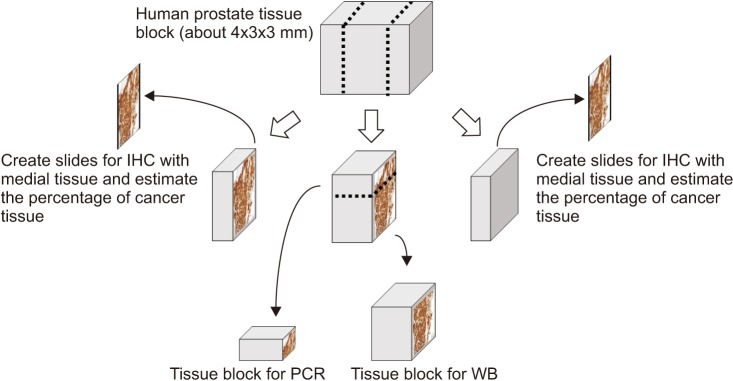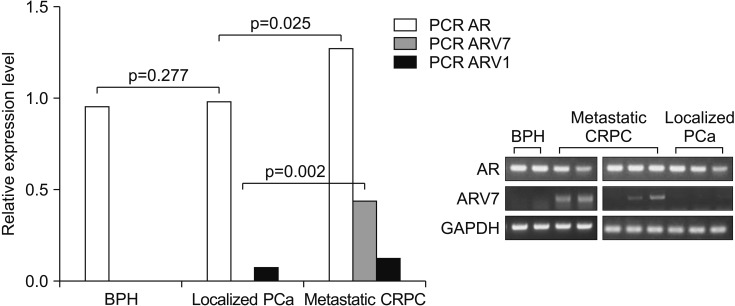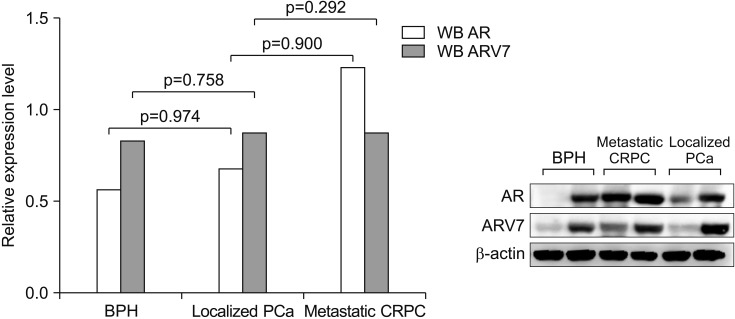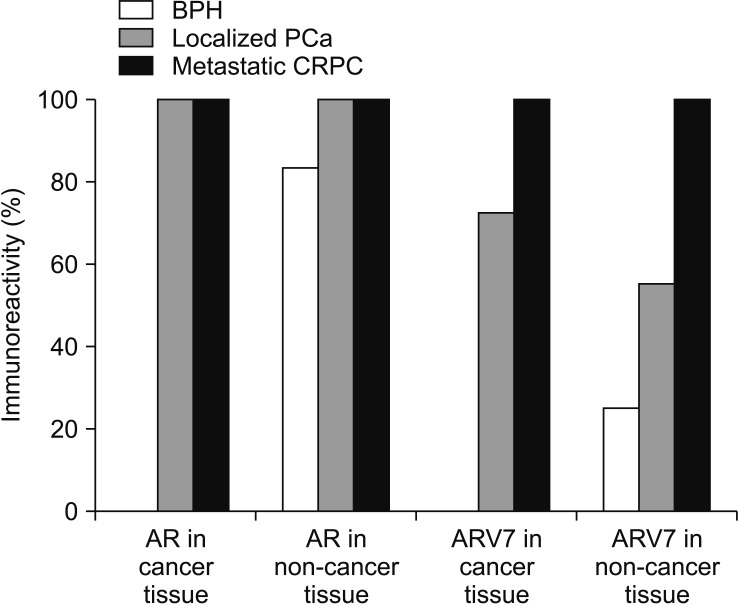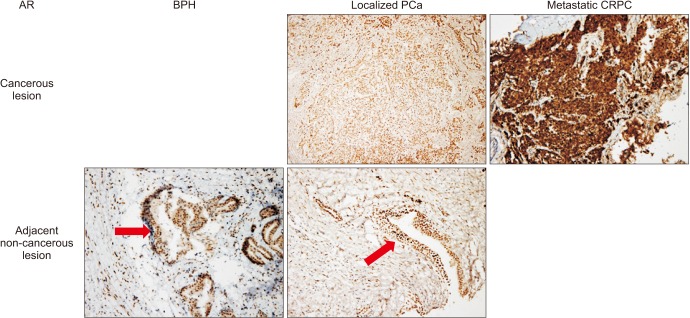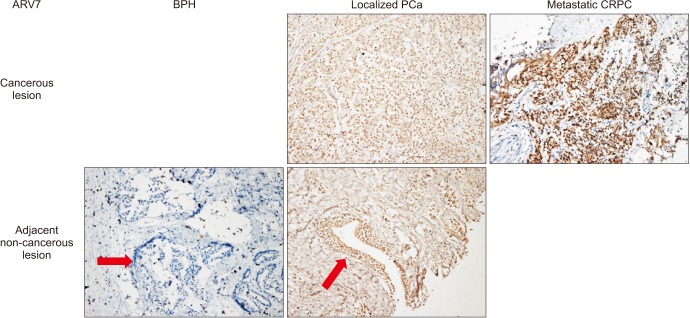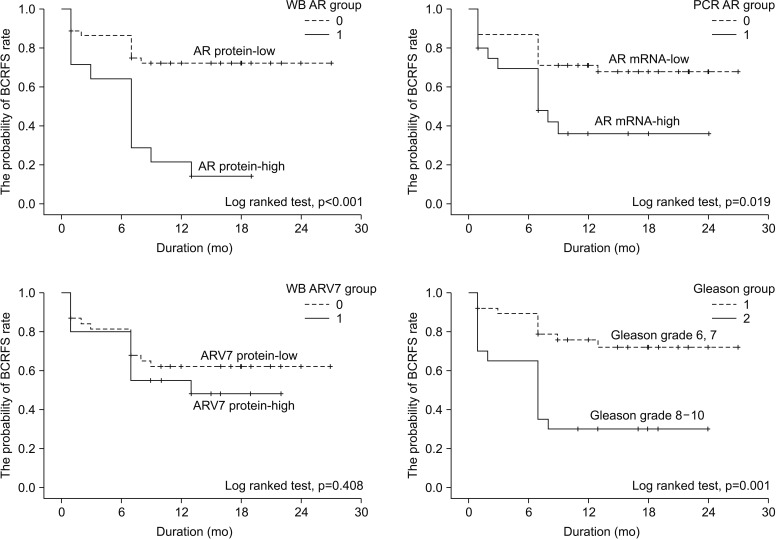World J Mens Health.
2019 Jan;37(1):68-77. 10.5534/wjmh.180003.
The Expression of Androgen Receptor and Its Variants in Human Prostate Cancer Tissue according to Disease Status, and Its Prognostic Significance
- Affiliations
-
- 1Department of Urology, Pusan National University Yangsan Hospital, Yangsan, Korea.
- 2Department of Pathology, Pusan National University Yangsan Hospital, Yangsan, Korea.
- 3Department of Anatomy, Pusan National University School of Medicine, Yangsan, Korea. sikyoon@pusan.ac.kr
- KMID: 2429723
- DOI: http://doi.org/10.5534/wjmh.180003
Abstract
- PURPOSE
To evaluate changes in the expression of androgen receptor (AR) and its variants (ARVs) in human prostate cancer (PCa) tissues according to disease status, and its prognostic significance following radical prostatectomy (RP).
MATERIALS AND METHODS
A total of 282 PCa cases were evaluated, which included 252 localized PCa, 8 metastatic castration resistant prostate cancer (CRPC), and 22 benign prostatic hyperplasia (BPH) cases. Samples were collected from patients who underwent RP or transurethral resection and were stored in ethically approved tissue banks. Quantitative real-time polymerase chain reaction, Western blotting, and immunohistochemistry were performed for AR and ARVs. Each tissue was confirmed as cancerous (greater than 80%) using hematoxylin and eosin staining. AR and ARVs expression was compared according to disease status. The biochemical recurrence free survival (BCRFS) rates in men with localized PCa was analyzed according to AR and ARV7 expression using the Kaplan-Meier curve.
RESULTS
Only 58 of the 252 localized PCa were included in the analysis because of insufficient cancer tissue. AR and ARV7 mRNA expression was higher in the CRPC tissue than in the localized PCa tissue (p=0.025, p=0.002, respectively). In localized PCa tissue, high AR mRNA and protein level was associated with a low BCRFS rate (log-ranked, p=0.019, p < 0.001, respectively).
CONCLUSIONS
Overall AR and ARV7 mRNA expression levels were increased in CRPC tissues compared to localized PCa and BPH tissues. High AR protein and mRNA expression in the tumor tissue may be considered a predictive factor of BCRFS following RP.
MeSH Terms
-
Blotting, Western
Castration
Eosine Yellowish-(YS)
Hematoxylin
Humans*
Immunohistochemistry
Male
Passive Cutaneous Anaphylaxis
Prostate*
Prostatectomy
Prostatic Hyperplasia
Prostatic Neoplasms*
Real-Time Polymerase Chain Reaction
Receptors, Androgen*
Recurrence
RNA, Messenger
Tissue Banks
Eosine Yellowish-(YS)
Hematoxylin
RNA, Messenger
Receptors, Androgen
Figure
Reference
-
1. Hoang DT, Iczkowski KA, Kilari D, See W, Nevalainen MT. Androgen receptor-dependent and -independent mechanisms driving prostate cancer progression: opportunities for therapeutic targeting from multiple angles. Oncotarget. 2017; 8:3724–3745. PMID: 27741508.
Article2. Taplin ME, Bubley GJ, Shuster TD, Frantz ME, Spooner AE, Ogata GK, et al. Mutation of the androgen-receptor gene in metastatic androgen-independent prostate cancer. N Engl J Med. 1995; 332:1393–1398. PMID: 7723794.
Article3. Sun S, Sprenger CC, Vessella RL, Haugk K, Soriano K, Mostaghel EA, et al. Castration resistance in human prostate cancer is conferred by a frequently occurring androgen receptor splice variant. J Clin Invest. 2010; 120:2715–2730. PMID: 20644256.
Article4. Molina A, Belldegrun A. Novel therapeutic strategies for castration resistant prostate cancer: inhibition of persistent androgen production and androgen receptor mediated signaling. J Urol. 2011; 185:787–794. PMID: 21239012.
Article5. Antonarakis ES, Lu C, Wang H, Luber B, Nakazawa M, Roeser JC, et al. AR-V7 and resistance to enzalutamide and abiraterone in prostate cancer. N Engl J Med. 2014; 371:1028–1038. PMID: 25184630.
Article6. Guerrero J, Alfaro IE, Gómez F, Protter AA, Bernales S. Enzalutamide, an androgen receptor signaling inhibitor, induces tumor regression in a mouse model of castration-resistant prostate cancer. Prostate. 2013; 73:1291–1305. PMID: 23765603.
Article7. Peer A, Gottfried M, Sinibaldi V, Carducci MA, Eisenberger MA, Sella A, et al. Comparison of abiraterone acetate versus ketoconazole in patients with metastatic castration resistant prostate cancer refractory to docetaxel. Prostate. 2014; 74:433–440. PMID: 24338986.
Article8. Ishikura N, Kawata H, Nishimoto A, Nakamura R, Ishii N, Aoki Y. Establishment and characterization of an androgen receptor-dependent, androgen-independent human prostate cancer cell line, LNCaP-CS10. Prostate. 2010; 70:457–466. PMID: 19902465.
Article9. Litvinov IV, Antony L, Dalrymple SL, Becker R, Cheng L, Isaacs JT. PC3, but not DU145, human prostate cancer cells retain the coregulators required for tumor suppressor ability of androgen receptor. Prostate. 2006; 66:1329–1338. PMID: 16835890.
Article10. Takeda H, Akakura K, Masai M, Akimoto S, Yatani R, Shimazaki J. Androgen receptor content of prostate carcinoma cells estimated by immunohistochemistry is related to prognosis of patients with stage D2 prostate carcinoma. Cancer. 1996; 77:934–940. PMID: 8608487.
Article11. Sweat SD, Pacelli A, Bergstralh EJ, Slezak JM, Cheng L, Bostwick DG. Androgen receptor expression in prostate cancer lymph node metastases is predictive of outcome after surgery. J Urol. 1999; 161:1233–1237. PMID: 10081876.
Article12. Li R, Wheeler T, Dai H, Frolov A, Thompson T, Ayala G. High level of androgen receptor is associated with aggressive clinicopathologic features and decreased biochemical recurrence-free survival in prostate: cancer patients treated with prostatectomy. Am J Surg Pathol. 2004; 28:928–934. PMID: 15223964.13. Ricciardelli C, Choong CS, Buchanan G, Vivekanandan S, Neufing P, Stahl J, et al. Androgen receptor levels in prostate cancer epithelial and peritumoral stromal cells identify non-organ confined disease. Prostate. 2005; 63:19–28. PMID: 15378523.
Article14. Rosner IL, Ravindranath L, Furusato B, Chen Y, Gao C, Cullen J, et al. Higher tumor to benign ratio of the androgen receptor mRNA expression associates with prostate cancer progression after radical prostatectomy. Urology. 2007; 70:1225–1229. PMID: 18158066.
Article15. Wikström P, Marusic J, Stattin P, Bergh A. Low stroma androgen receptor level in normal and tumor prostate tissue is related to poor outcome in prostate cancer patients. Prostate. 2009; 69:799–809. PMID: 19189305.
Article16. Minner S, Enodien M, Sirma H, Luebke AM, Krohn A, Mayer PS, et al. ERG status is unrelated to PSA recurrence in radically operated prostate cancer in the absence of antihormonal therapy. Clin Cancer Res. 2011; 17:5878–5888. PMID: 21791629.
Article17. Guo Z, Dai B, Jiang T, Xu K, Xie Y, Kim O, et al. Regulation of androgen receptor activity by tyrosine phosphorylation. Cancer Cell. 2006; 10:309–319. PMID: 17045208.
Article18. Segawa N, Mori I, Utsunomiya H, Nakamura M, Nakamura Y, Shan L, et al. Prognostic significance of neuroendocrine differentiation, proliferation activity and androgen receptor expression in prostate cancer. Pathol Int. 2001; 51:452–459. PMID: 11422807.
Article19. Henshall SM, Quinn DI, Lee CS, Head DR, Golovsky D, Brenner PC, et al. Altered expression of androgen receptor in the malignant epithelium and adjacent stroma is associated with early relapse in prostate cancer. Cancer Res. 2001; 61:423–427. PMID: 11212224.20. Leach DA, Need EF, Toivanen R, Trotta AP, Palethorpe HM, Tamblyn DJ, et al. Stromal androgen receptor regulates the composition of the microenvironment to influence prostate cancer outcome. Oncotarget. 2015; 6:16135–16150. PMID: 25965833.
Article21. Culig Z, Bartsch G. Androgen axis in prostate cancer. J Cell Biochem. 2006; 99:373–381. PMID: 16598769.
Article22. Hu R, Dunn TA, Wei S, Isharwal S, Veltri RW, Humphreys E, et al. Ligand-independent androgen receptor variants derived from splicing of cryptic exons signify hormone-refractory prostate cancer. Cancer Res. 2009; 69:16–22. PMID: 19117982.
Article
- Full Text Links
- Actions
-
Cited
- CITED
-
- Close
- Share
- Similar articles
-
- Immunohistochemical Assay of Androgen Receptor in Prostate Cancer
- Differentiation Related Gene (Drg-1) as a Molecular Marker during the Treatment of in vitro Intermittent Androgen Deprivation in prostate Cancer
- Correlation of AR, EGFR, and HER2 Expression Levels in Prostate Cancer: Immunohistochemical Analysis and Chromogenic In Situ Hybridization
- Role of Androgen Receptor in Prostate Cancer: A Review
- Expression of Androgen Receptor, bcl-2 Protein and Rb Protein in Breast Cancers as Related to Prognostic Factors

